Jiahao Qiu
A Survey of Self-Evolving Agents: On Path to Artificial Super Intelligence
Jul 28, 2025Abstract:Large Language Models (LLMs) have demonstrated strong capabilities but remain fundamentally static, unable to adapt their internal parameters to novel tasks, evolving knowledge domains, or dynamic interaction contexts. As LLMs are increasingly deployed in open-ended, interactive environments, this static nature has become a critical bottleneck, necessitating agents that can adaptively reason, act, and evolve in real time. This paradigm shift -- from scaling static models to developing self-evolving agents -- has sparked growing interest in architectures and methods enabling continual learning and adaptation from data, interactions, and experiences. This survey provides the first systematic and comprehensive review of self-evolving agents, organized around three foundational dimensions -- what to evolve, when to evolve, and how to evolve. We examine evolutionary mechanisms across agent components (e.g., models, memory, tools, architecture), categorize adaptation methods by stages (e.g., intra-test-time, inter-test-time), and analyze the algorithmic and architectural designs that guide evolutionary adaptation (e.g., scalar rewards, textual feedback, single-agent and multi-agent systems). Additionally, we analyze evaluation metrics and benchmarks tailored for self-evolving agents, highlight applications in domains such as coding, education, and healthcare, and identify critical challenges and research directions in safety, scalability, and co-evolutionary dynamics. By providing a structured framework for understanding and designing self-evolving agents, this survey establishes a roadmap for advancing adaptive agentic systems in both research and real-world deployments, ultimately shedding lights to pave the way for the realization of Artificial Super Intelligence (ASI), where agents evolve autonomously, performing at or beyond human-level intelligence across a wide array of tasks.
ReasonFlux-PRM: Trajectory-Aware PRMs for Long Chain-of-Thought Reasoning in LLMs
Jun 23, 2025



Abstract:Process Reward Models (PRMs) have recently emerged as a powerful framework for supervising intermediate reasoning steps in large language models (LLMs). Previous PRMs are primarily trained on model final output responses and struggle to evaluate intermediate thinking trajectories robustly, especially in the emerging setting of trajectory-response outputs generated by frontier reasoning models like Deepseek-R1. In this work, we introduce ReasonFlux-PRM, a novel trajectory-aware PRM explicitly designed to evaluate the trajectory-response type of reasoning traces. ReasonFlux-PRM incorporates both step-level and trajectory-level supervision, enabling fine-grained reward assignment aligned with structured chain-of-thought data. We adapt ReasonFlux-PRM to support reward supervision under both offline and online settings, including (i) selecting high-quality model distillation data for downstream supervised fine-tuning of smaller models, (ii) providing dense process-level rewards for policy optimization during reinforcement learning, and (iii) enabling reward-guided Best-of-N test-time scaling. Empirical results on challenging downstream benchmarks such as AIME, MATH500, and GPQA-Diamond demonstrate that ReasonFlux-PRM-7B selects higher quality data than strong PRMs (e.g., Qwen2.5-Math-PRM-72B) and human-curated baselines. Furthermore, our derived ReasonFlux-PRM-7B yields consistent performance improvements, achieving average gains of 12.1% in supervised fine-tuning, 4.5% in reinforcement learning, and 6.3% in test-time scaling. We also release our efficient ReasonFlux-PRM-1.5B for resource-constrained applications and edge deployment. Projects: https://github.com/Gen-Verse/ReasonFlux
AgentDistill: Training-Free Agent Distillation with Generalizable MCP Boxes
Jun 17, 2025Abstract:While knowledge distillation has become a mature field for compressing large language models (LLMs) into smaller ones by aligning their outputs or internal representations, the distillation of LLM-based agents, which involve planning, memory, and tool use, remains relatively underexplored. Existing agent distillation methods typically replay full teacher trajectories or imitate step-by-step teacher tool usage, but they often struggle to train student agents to dynamically plan and act in novel environments. We propose AgentDistill, a novel, training-free agent distillation framework that enables efficient and scalable knowledge transfer via direct reuse of Model-Context-Protocols (MCPs), which are structured and reusable task-solving modules autonomously generated by teacher agents. The reuse of these distilled MCPs enables student agents to generalize their capabilities across domains and solve new problems with minimal supervision or human intervention. Experiments on biomedical and mathematical benchmarks demonstrate that our distilled student agents, built on small language models, can achieve performance comparable to advanced systems using large LLMs such as OctoTools (GPT-4o), highlighting the effectiveness of our framework in building scalable and cost-efficient intelligent agents.
On Path to Multimodal Historical Reasoning: HistBench and HistAgent
May 26, 2025Abstract:Recent advances in large language models (LLMs) have led to remarkable progress across domains, yet their capabilities in the humanities, particularly history, remain underexplored. Historical reasoning poses unique challenges for AI, involving multimodal source interpretation, temporal inference, and cross-linguistic analysis. While general-purpose agents perform well on many existing benchmarks, they lack the domain-specific expertise required to engage with historical materials and questions. To address this gap, we introduce HistBench, a new benchmark of 414 high-quality questions designed to evaluate AI's capacity for historical reasoning and authored by more than 40 expert contributors. The tasks span a wide range of historical problems-from factual retrieval based on primary sources to interpretive analysis of manuscripts and images, to interdisciplinary challenges involving archaeology, linguistics, or cultural history. Furthermore, the benchmark dataset spans 29 ancient and modern languages and covers a wide range of historical periods and world regions. Finding the poor performance of LLMs and other agents on HistBench, we further present HistAgent, a history-specific agent equipped with carefully designed tools for OCR, translation, archival search, and image understanding in History. On HistBench, HistAgent based on GPT-4o achieves an accuracy of 27.54% pass@1 and 36.47% pass@2, significantly outperforming LLMs with online search and generalist agents, including GPT-4o (18.60%), DeepSeek-R1(14.49%) and Open Deep Research-smolagents(20.29% pass@1 and 25.12% pass@2). These results highlight the limitations of existing LLMs and generalist agents and demonstrate the advantages of HistAgent for historical reasoning.
Alita: Generalist Agent Enabling Scalable Agentic Reasoning with Minimal Predefinition and Maximal Self-Evolution
May 26, 2025Abstract:Recent advances in large language models (LLMs) have enabled agents to autonomously perform complex, open-ended tasks. However, many existing frameworks depend heavily on manually predefined tools and workflows, which hinder their adaptability, scalability, and generalization across domains. In this work, we introduce Alita--a generalist agent designed with the principle of "Simplicity is the ultimate sophistication," enabling scalable agentic reasoning through minimal predefinition and maximal self-evolution. For minimal predefinition, Alita is equipped with only one component for direct problem-solving, making it much simpler and neater than previous approaches that relied heavily on hand-crafted, elaborate tools and workflows. This clean design enhances its potential to generalize to challenging questions, without being limited by tools. For Maximal self-evolution, we enable the creativity of Alita by providing a suite of general-purpose components to autonomously construct, refine, and reuse external capabilities by generating task-related model context protocols (MCPs) from open source, which contributes to scalable agentic reasoning. Notably, Alita achieves 75.15% pass@1 and 87.27% pass@3 accuracy, which is top-ranking among general-purpose agents, on the GAIA benchmark validation dataset, 74.00% and 52.00% pass@1, respectively, on Mathvista and PathVQA, outperforming many agent systems with far greater complexity. More details will be updated at $\href{https://github.com/CharlesQ9/Alita}{https://github.com/CharlesQ9/Alita}$.
Shallow Preference Signals: Large Language Model Aligns Even Better with Truncated Data?
May 21, 2025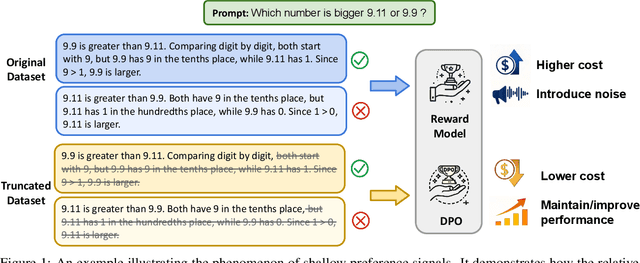
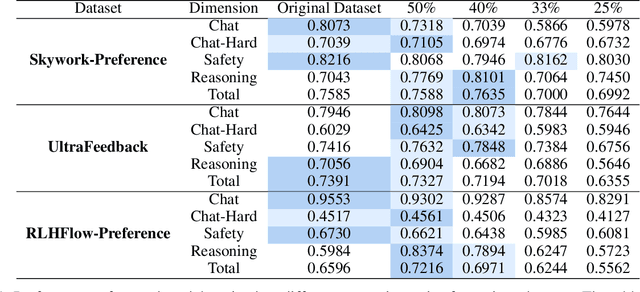

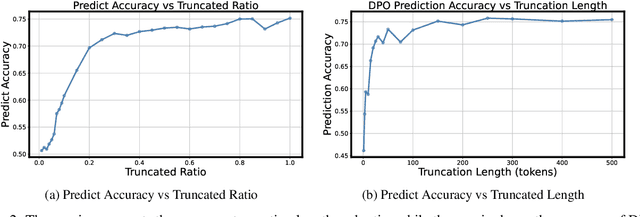
Abstract:Aligning large language models (LLMs) with human preferences remains a key challenge in AI. Preference-based optimization methods, such as Reinforcement Learning with Human Feedback (RLHF) and Direct Preference Optimization (DPO), rely on human-annotated datasets to improve alignment. In this work, we identify a crucial property of the existing learning method: the distinguishing signal obtained in preferred responses is often concentrated in the early tokens. We refer to this as shallow preference signals. To explore this property, we systematically truncate preference datasets at various points and train both reward models and DPO models on the truncated data. Surprisingly, models trained on truncated datasets, retaining only the first half or fewer tokens, achieve comparable or even superior performance to those trained on full datasets. For example, a reward model trained on the Skywork-Reward-Preference-80K-v0.2 dataset outperforms the full dataset when trained on a 40\% truncated dataset. This pattern is consistent across multiple datasets, suggesting the widespread presence of shallow preference signals. We further investigate the distribution of the reward signal through decoding strategies. We consider two simple decoding strategies motivated by the shallow reward signal observation, namely Length Control Decoding and KL Threshold Control Decoding, which leverage shallow preference signals to optimize the trade-off between alignment and computational efficiency. The performance is even better, which again validates our hypothesis. The phenomenon of shallow preference signals highlights potential issues in LLM alignment: existing alignment methods often focus on aligning only the initial tokens of responses, rather than considering the full response. This could lead to discrepancies with real-world human preferences, resulting in suboptimal alignment performance.
OTC: Optimal Tool Calls via Reinforcement Learning
Apr 21, 2025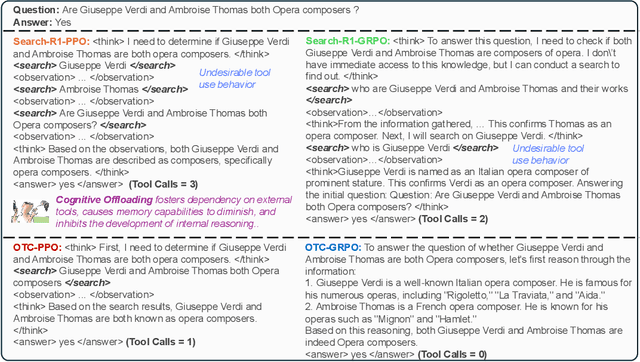
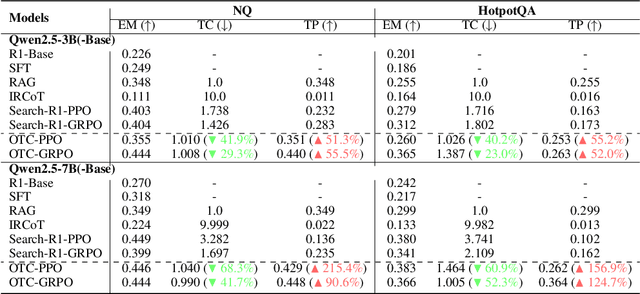

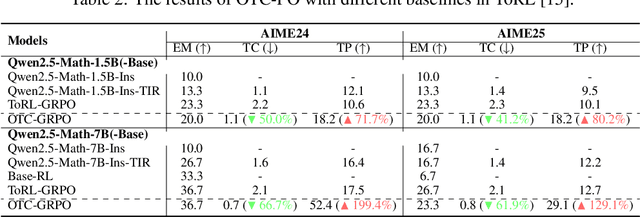
Abstract:Tool-integrated reasoning (TIR) augments large language models (LLMs) with the ability to invoke external tools, such as search engines and code interpreters, to solve tasks beyond the capabilities of language-only reasoning. While reinforcement learning (RL) has shown promise in improving TIR by optimizing final answer correctness, existing approaches often overlook the efficiency and cost associated with tool usage. This can lead to suboptimal behavior, including excessive tool calls that increase computational and financial overhead, or insufficient tool use that compromises answer quality. In this work, we propose Optimal Tool Call-controlled Policy Optimization (OTC-PO), a simple yet effective RL-based framework that encourages models to produce accurate answers with minimal tool calls. Our method introduces a tool-integrated reward that jointly considers correctness and tool efficiency, promoting high tool productivity. We instantiate this framework within both Proximal Policy Optimization (PPO) and Group Relative Preference Optimization (GRPO), resulting in OTC-PPO and OTC-GRPO. Experiments with Qwen-2.5 and Qwen-Math across multiple QA benchmarks show that our approach reduces tool calls by up to 73.1\% and improves tool productivity by up to 229.4\%, while maintaining comparable answer accuracy. To the best of our knowledge, this is the first RL-based framework that explicitly optimizes tool-use efficiency in TIR.
EmoAgent: Assessing and Safeguarding Human-AI Interaction for Mental Health Safety
Apr 13, 2025Abstract:The rise of LLM-driven AI characters raises safety concerns, particularly for vulnerable human users with psychological disorders. To address these risks, we propose EmoAgent, a multi-agent AI framework designed to evaluate and mitigate mental health hazards in human-AI interactions. EmoAgent comprises two components: EmoEval simulates virtual users, including those portraying mentally vulnerable individuals, to assess mental health changes before and after interactions with AI characters. It uses clinically proven psychological and psychiatric assessment tools (PHQ-9, PDI, PANSS) to evaluate mental risks induced by LLM. EmoGuard serves as an intermediary, monitoring users' mental status, predicting potential harm, and providing corrective feedback to mitigate risks. Experiments conducted in popular character-based chatbots show that emotionally engaging dialogues can lead to psychological deterioration in vulnerable users, with mental state deterioration in more than 34.4% of the simulations. EmoGuard significantly reduces these deterioration rates, underscoring its role in ensuring safer AI-human interactions. Our code is available at: https://github.com/1akaman/EmoAgent
Harnessing the Reasoning Economy: A Survey of Efficient Reasoning for Large Language Models
Mar 31, 2025Abstract:Recent advancements in Large Language Models (LLMs) have significantly enhanced their ability to perform complex reasoning tasks, transitioning from fast and intuitive thinking (System 1) to slow and deep reasoning (System 2). While System 2 reasoning improves task accuracy, it often incurs substantial computational costs due to its slow thinking nature and inefficient or unnecessary reasoning behaviors. In contrast, System 1 reasoning is computationally efficient but leads to suboptimal performance. Consequently, it is critical to balance the trade-off between performance (benefits) and computational costs (budgets), giving rise to the concept of reasoning economy. In this survey, we provide a comprehensive analysis of reasoning economy in both the post-training and test-time inference stages of LLMs, encompassing i) the cause of reasoning inefficiency, ii) behavior analysis of different reasoning patterns, and iii) potential solutions to achieve reasoning economy. By offering actionable insights and highlighting open challenges, we aim to shed light on strategies for improving the reasoning economy of LLMs, thereby serving as a valuable resource for advancing research in this evolving area. We also provide a public repository to continually track developments in this fast-evolving field.
Collab: Controlled Decoding using Mixture of Agents for LLM Alignment
Mar 27, 2025Abstract:Alignment of Large Language models (LLMs) is crucial for safe and trustworthy deployment in applications. Reinforcement learning from human feedback (RLHF) has emerged as an effective technique to align LLMs to human preferences and broader utilities, but it requires updating billions of model parameters, which is computationally expensive. Controlled Decoding, by contrast, provides a mechanism for aligning a model at inference time without retraining. However, single-agent decoding approaches often struggle to adapt to diverse tasks due to the complexity and variability inherent in these tasks. To strengthen the test-time performance w.r.t the target task, we propose a mixture of agent-based decoding strategies leveraging the existing off-the-shelf aligned LLM policies. Treating each prior policy as an agent in the spirit of mixture of agent collaboration, we develop a decoding method that allows for inference-time alignment through a token-level selection strategy among multiple agents. For each token, the most suitable LLM is dynamically chosen from a pool of models based on a long-term utility metric. This policy-switching mechanism ensures optimal model selection at each step, enabling efficient collaboration and alignment among LLMs during decoding. Theoretical analysis of our proposed algorithm establishes optimal performance with respect to the target task represented via a target reward for the given off-the-shelf models. We conduct comprehensive empirical evaluations with open-source aligned models on diverse tasks and preferences, which demonstrates the merits of this approach over single-agent decoding baselines. Notably, Collab surpasses the current SoTA decoding strategy, achieving an improvement of up to 1.56x in average reward and 71.89% in GPT-4 based win-tie rate.
 Add to Chrome
Add to Chrome Add to Firefox
Add to Firefox Add to Edge
Add to Edge